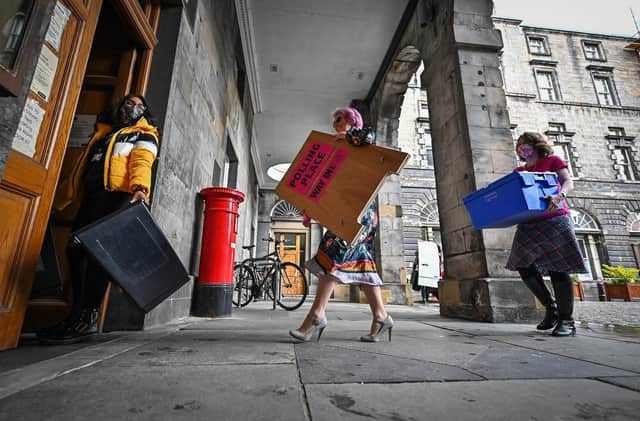Scotland council elections 2022: Gender equality in council chambers requires urgent reform – Susan Dalgety


“I want to be challenged, and I want this government and our work to be challenged to ensure we get this right first time and the future for women and girls becomes the fairest and most prosperous it can be,” she said at a virtual meeting of the National Advisory Council on Women and Girls.
Taking what she said at face value – always a risk these days with senior politicians, I admit – I have a challenge for the First Minister. Will her government introduce a bill to legislate for equal representation for women at all levels of governance, Holyrood and local government, working with Westminster if necessary?
Advertisement
Hide AdAdvertisement
Hide AdI ask because once again it looks as if, come May 6, many of Scotland’s council chambers will resemble a golf club lounge, packed full of slightly overweight, middle-aged men with a smattering of women bringing some spark to the conversation.
Despite the very welcome advances in women’s representation in the Scottish Parliament, with 58 females (45 per cent) winning seats at last year’s elections, councils look set to remain stubbornly male-dominated.
At the last council elections, five years ago, only 29 per cent of seats were filled with women, and a sample analysis of the sex of the 2022 candidates suggests little has improved.
I am not a political scientist, and my research makes assumptions about people’s names and their photographs online, but even a cursory examination of three areas in the east of Scotland – Borders, East Lothian and the City of Edinburgh – makes for depressing reading.
There are 270 candidates across the three councils, and only 99 (37 per cent) are women. I must add a caveat to my research. It may be 98 women, but I have not been able to identify the sex of one the Vanguard Party candidates in the Borders.
Perhaps surprisingly, East Lothian emerges as the most woman-friendly, with 22 female candidates out of 50 (44 per cent). Edinburgh has 51 women standing out of 143 (36 per cent).
In defence of the First Minister, admittedly a phrase I very rarely use, I feel duty-bound to point out that the SNP is fielding 12 female candidates out of 25 in the capital, which is as near 50-50 as you can get. But there is one ward in the city, which covers the leafy suburbs of Corstorphine and Murrayfield, where all seven contenders are blokes.
The Borders, home to the candidate with the unisex name, the camera-shy Sunny Smith, Vanguard Party candidate for the Kelso and District ward, lags a little behind with 34 per cent of its candidates female.
Advertisement
Hide AdAdvertisement
Hide AdIf this male-female split is replicated across the country, you don’t need to be a political scientist to hazard a guess that once the votes are counted local government will remain male-dominated.
I have long given up wondering why this should be so. What I do know is that if we want better public services, we should make sure our councillors represent the communities they serve, and that means half should be women.
And I do know that the solution is not simply to encourage more women to stand for election, though that does help, but to introduce mandatory quotas so that political parties have to field a balanced ticket, opening up their selection processes to public scrutiny.
Just days after the referendum that ripped our country apart, I sent an email that resulted in the establishment of the Women: 50-50 campaign, a cause the First Minister says she is “proud to support".
I had come a long way from when I was an enthusiastic young councillor in the 1990s. Back then I, and others like me, were buoyed up by the success of second-wave feminism. We knew that, as women, we could make it on merit alone. The war of the sexes had been won, the future was female. How naïve we were.
By September 2014, the evidence was unassailable. Securing, and crucially sustaining, equality of representation would only be achieved through mandatory quotas, which is why I sent that missive.
Sadly, the women’s movement in Scotland has fractured since then, divided, almost unbelievably, by a disagreement about what it means to be a woman. Many of the women I once stood shoulder to shoulder with now regard me as a dinosaur for believing that sex matters.
But, as I wrote only last month, there is an upside to the sometimes fractious debate about sex versus gender identity. It has led to a resurgence in Scotland’s grassroots women’s movement, with groups of women springing up all over the place, campaigning, as For Women Scotland put it on their website, to “protect and strengthen” women’s rights.
Advertisement
Hide AdAdvertisement
Hide AdThere is no better way to strengthen those rights, and the governance of Scotland, than by ensuring that local government is truly representative. And that means fewer blokes.
The Scottish Government has set up a survey to get a better picture of who stood for the council elections, and the results will be published later this year. I hope that they will give Nicola Sturgeon enough evidence to prove to her that urgent reform is needed in time for the 2027 council elections.
The SNP recently indicated that they want 16-year-olds to be able to stand for election, but before they let teenagers loose on school closures, social care budgets and planning applications, perhaps the focus should be on getting more women into power.
Comments
Want to join the conversation? Please or to comment on this article.
